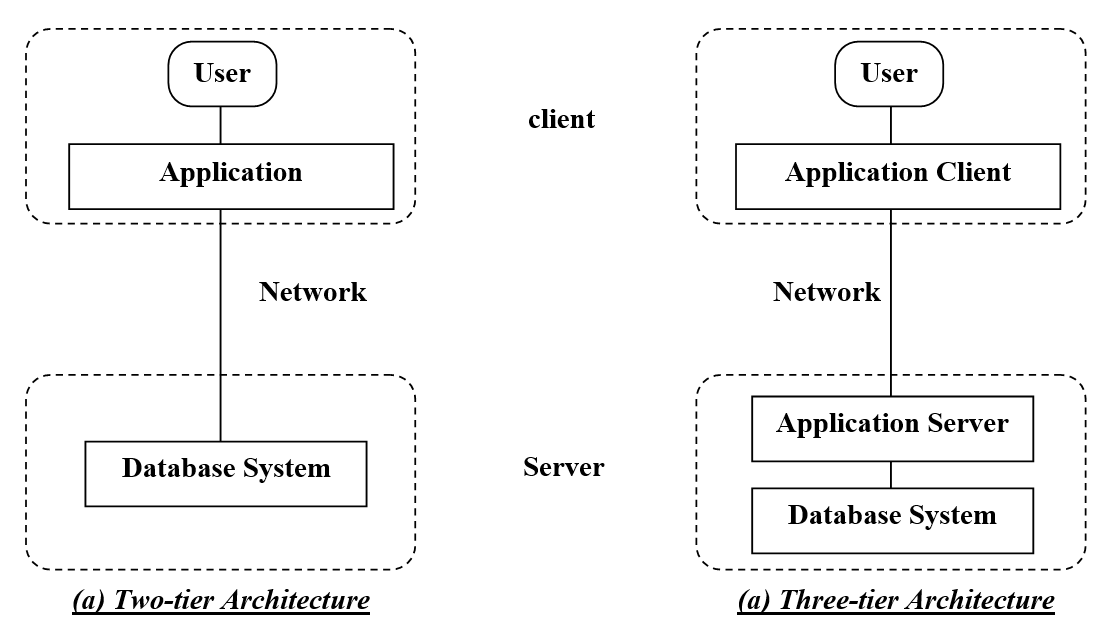Difference Between Two Tier and Three Tier Architecture in JavaThe structure and functionality of two-tier and three-tier database designs are fundamentally different. Before learning about the difference between two-tier and three-tier architecture, let us learn about the two-tier architecture first. The client and the database server. In this case, the client connects directly with the database, making it easier but less scalable. Between the client and the database server, a Three Tier Design adds an intermediate layer, the application server. By allowing the application server to conduct business logic separately, this separation improves scalability, security, and maintainability. While Two-Tier is simpler, Three-Tier provides more flexibility and robustness for complicated applications, making it the preferred choice for enterprise-level systems. 
1. Two-Tier ArchitectureA basic notion in database administration is two-tier database architecture. It is the basis for many applications and systems that rely on effective data storage and retrieval. Two-tier database architecture comprises two primary components: the client and the database server. The method is prevalent in client-server systems where the client (user interface) interfaces directly with the database server (data storage and processing). Client Tier:The client tier is the system's user-facing component, sometimes known as the front end. It contains the program's graphical user interface (GUI), with which users interact to enter, access, and manipulate data. Client tier is responsible for sending database server requests and showing the results. Database Server Tier:The database server tier controls data storage, retrieval, and administration. It handles incoming client-tier requests, conducts database queries, and returns the needed data. The layer stores and organizes actual data, assuring data integrity and security. A two-tier database design is suited for smaller-scale applications due to its simplicity and performance. It allows the client to communicate directly with the database server, eliminating network overhead and enhancing speed. A two-tier database design simplifies user-database interaction by splitting the system into client and database server tiers. It's a valuable option for many applications, especially those with moderate data processing needs. It's crucial knowledge for those in database maintenance and application development. 2. Three-Tier Database ArchitectureBefore learning about the difference between two-tier and three-tier architecture, let us learn about the three-tier architecture. Effective database design is crucial for program efficiency, scalability, and reliability in today's software development industry, with the Three-Tier Database Architecture being a popular choice. This approach divides the database system into three separate tiers: the presentation tier, the application tier, and the data tier. Let's break each rung down into basic words. Presentation Tier:This is the uppermost layer, sometimes known as the user interface. It is what users directly engage with. Everything linked to the user experience, such as web pages, mobile applications, and graphical interfaces, is included in this tier. The key objective here is to create a user-friendly and visually beautiful interface. Application Tier:This layer, located in the center, links the presentation and data levels. It houses the business logic as well as the application processing. When a user submits a request, the application layer executes it, retrieving or updating data from the data tier and returning the results to the presentation tier. It functions as the system's brain. Data Tier:The data tier is at the heart of the architecture. It is the location where all data is saved and maintained. Databases such as MySQL, PostgreSQL, and MongoDB are often utilized here. Data integrity, security, and fast retrieval and storage are all ensured by the data tier. The versatility and scalability of the Three-Tier Database Architecture are its highlights. Each layer may be built, maintained, and scaled individually, making adaptation to changing requirements easy. It also improves security by isolating sensitive data in the data layer. The design provides a clear separation of concerns, making programs more manageable and resilient. It is the foundation of many current systems and an essential notion for anybody entering the field of software development. Difference Between Two-Tier and Three-Tier Database Architecture
ConclusionThree-tier design is extremely scalable, and ideal for complex and dispersed systems, whereas two-tier architecture is less scalable. Three-tier design provides a strong separation of concerns, with separate layers for display, business logic, and data storage, whereas two-tier architecture provides minimal separation. Three-tier design enables increased security measures at each layer, allowing for more control over user access. In contrast, two-tier architecture can be more difficult to administer regarding security. Compared to a Two-Tier design, where modifications might affect client-database interactions, Three-Tier architecture allows for easier maintenance and upgrades since changes are frequently confined to one layer. Two-tier architecture is appropriate for small-scale applications or prototypes, but the three-tier design is favoured for bigger, more complicated systems, especially those in dispersed contexts. |
 For Videos Join Our Youtube Channel: Join Now
For Videos Join Our Youtube Channel: Join Now
Feedback
- Send your Feedback to [email protected]
Help Others, Please Share









